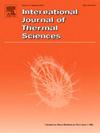Influence of initial pressure on the flow dynamics and thermal behavior of a single loop pulsating heat pipe
IF 4.9
2区 工程技术
Q1 ENGINEERING, MECHANICAL
International Journal of Thermal Sciences
Pub Date : 2025-01-28
DOI:10.1016/j.ijthermalsci.2025.109720
引用次数: 0
Abstract
Non-condensable gases (NCGs) are a major factor influencing both the thermal performance and the durability of two-phase heat transfer systems. In particular, NCGs can have a substantial impact on the functionality of a pulsating heat pipe (PHP). In this study, the effects of NCGs were investigated at four different initial system pressure levels: 3.172 kPa, 3.741 kPa, 6.263 kPa, and 20.112 kPa. These pressure levels were achieved by varying the degassing levels of the working fluid. A single-loop PHP made of borosilicate glass with a uniform inner diameter of 2.5 mm was used for the experiment. The study was conducted at a 50% filling ratio in a vertical orientation, using water as the working fluid. The results indicate that the presence of NCGs leads to a subcooling effect on the working fluid and hinders the flow inside the PHP. However, the negative effects of NCGs decrease as the heat load increases. It was observed that the average evaporator temperature rises with an increase in the initial pressure. While the thermal performance, in terms of equivalent thermal resistance, was best at the lowest initial pressure, the heat load capacity of the PHP at higher initial pressures increased by nearly 16% compared to those with lower initial pressures.
求助全文
约1分钟内获得全文
求助全文
来源期刊

International Journal of Thermal Sciences
工程技术-工程:机械
CiteScore
8.10
自引率
11.10%
发文量
531
审稿时长
55 days
期刊介绍:
The International Journal of Thermal Sciences is a journal devoted to the publication of fundamental studies on the physics of transfer processes in general, with an emphasis on thermal aspects and also applied research on various processes, energy systems and the environment. Articles are published in English and French, and are subject to peer review.
The fundamental subjects considered within the scope of the journal are:
* Heat and relevant mass transfer at all scales (nano, micro and macro) and in all types of material (heterogeneous, composites, biological,...) and fluid flow
* Forced, natural or mixed convection in reactive or non-reactive media
* Single or multi–phase fluid flow with or without phase change
* Near–and far–field radiative heat transfer
* Combined modes of heat transfer in complex systems (for example, plasmas, biological, geological,...)
* Multiscale modelling
The applied research topics include:
* Heat exchangers, heat pipes, cooling processes
* Transport phenomena taking place in industrial processes (chemical, food and agricultural, metallurgical, space and aeronautical, automobile industries)
* Nano–and micro–technology for energy, space, biosystems and devices
* Heat transport analysis in advanced systems
* Impact of energy–related processes on environment, and emerging energy systems
The study of thermophysical properties of materials and fluids, thermal measurement techniques, inverse methods, and the developments of experimental methods are within the scope of the International Journal of Thermal Sciences which also covers the modelling, and numerical methods applied to thermal transfer.
 求助内容:
求助内容: 应助结果提醒方式:
应助结果提醒方式:


